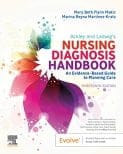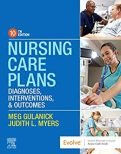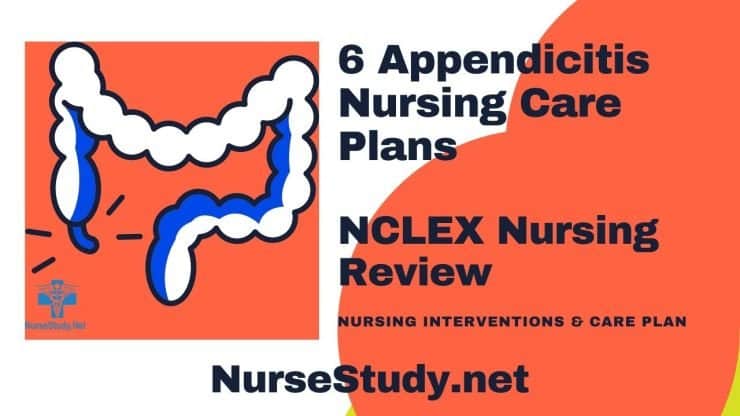Last updated on June 28th, 2023 at 09:39 am
Definition:
Appendicitis is a medical condition that occurs when there is an inflammation of the finger-shaped pouch near the colon called the appendix.
Defining Characteristics of Appendicitis:
Subjective:
- Abdominal pain, typically starting around the umbilicus and migrating to the right lower quadrant.
- Nausea and vomiting.
- Anorexia or decreased appetite.
- Low-grade fever.
Objective:
- Tenderness and rebound tenderness upon palpation of the right lower quadrant.
- Guarding or rigidity of the abdomen.
- Increased white blood cell count.
- Abdominal distension.
- Positive psoas sign or obturator sign.
Related Factors:
- Obstruction of the appendix lumen.
- Infection of the appendix.
Risk Population:
- Individuals of all ages can develop appendicitis, but it is most common in the age group of 10 to 30 years.
Associated Problems:
- Peritonitis.
- Abscess formation.
- Bowel obstruction.
Suggestions for Use:
- Assess the client’s medical history, including any previous episodes of abdominal pain or appendicitis.
- Monitor vital signs and abdominal pain intensity regularly.
- Educate the client about the signs and symptoms of worsening appendicitis and the importance of seeking immediate medical attention.
Suggested Alternative NANDA Diagnoses:
- Acute Pain related to inflammation and distension of the appendix.
- Risk for Infection related to compromised barrier defenses (appendix inflammation).
- Risk for Fluid Volume Deficit related to anorexia, vomiting, and decreased oral intake.
- Anxiety related to abdominal pain and uncertainty about the surgical intervention.
- Risk for Impaired Skin Integrity related to surgical incision and wound healing (post-appendectomy).
Usage Tips:
- Collaborate with the healthcare team to establish a definitive diagnosis and plan of care.
- Administer prescribed analgesics and antimicrobial agents as ordered.
- Provide comfort measures, such as applying a heating pad to the abdomen or assisting with positioning for pain relief.
NOC Outcomes:
- Pain Level: Self-Reported Severity (Numeric Rating Scale)
- Comfort Level
- Knowledge: Medication
- Infection Severity
- Nutritional Status: Food & Fluid Intake
NOC Results:
- Pain level decreased from 8/10 to 2/10 within 24 hours.
- Client reports improved comfort and ability to participate in activities of daily living.
- Client demonstrates an understanding of prescribed medications and their side effects.
- Infection severity decreases as evidenced by a reduction in signs of inflammation.
- Client maintains adequate food and fluid intake, preventing dehydration and malnutrition.
NIC Interventions:
- Pain Management:
- Assess pain intensity using a validated pain scale.
- Administer analgesics as prescribed and monitor their effectiveness.
- Provide non-pharmacological pain relief measures (e.g., positioning, relaxation techniques).
- Infection Control:
- Monitor vital signs and laboratory values for signs of systemic infection.
- Administer prescribed antimicrobial agents and educate the client on the importance of compliance.
- Implement proper hand hygiene and infection control precautions.
- Fluid Management:
- Monitor fluid intake and output.
- Encourage oral fluid intake if tolerated and administer intravenous fluids if necessary.
- Assess for signs of dehydration and intervene accordingly.
- Preoperative Preparation:
- Provide information about the surgical procedure, including risks and benefits.
- Address any concerns or fears expressed by the client.
- Ensure the client understands and follows the preoperative fasting instructions.
- Anxiety Reduction:
- Use therapeutic communication techniques to address the client’s fears and concerns.
- Provide emotional support and reassurance throughout the preoperative and postoperative periods.
- Teach relaxation techniques, such as deep breathing exercises, to promote stress reduction.
Nursing Care Plan for Appendicitis
Acute Pain Nursing Care Plan for Appendicitis
Nursing Diagnosis: Acute Pain related to inflammation and distension of the appendix
Related Factors/Causes:
- Obstruction of the appendix lumen
- Infection of the appendix
Desired Outcomes:
- The client will experience reduced pain intensity within 24 hours.
- The client will demonstrate relief or decreased discomfort as evidenced by verbal reports and decreased guarding of the abdomen.
- The client will be able to participate in activities of daily living with improved comfort.
Nursing Interventions for Appendicitis:
- Assess Pain:
- Use a pain scale to assess pain intensity.
- Ask the client to describe the location, characteristics, and intensity of pain.
- Monitor vital signs and changes in pain level before and after interventions.
- Provide Comfort Measures:
- Assist the client in finding a comfortable position, such as lying on the side with the knees flexed.
- Apply a heating pad or warm compress to the abdomen, if appropriate and prescribed.
- Encourage relaxation techniques, such as deep breathing exercises or guided imagery, to promote pain relief.
- Administer Analgesics:
- Administer prescribed analgesic medications as ordered by the healthcare provider.
- Monitor the client’s response to the medication, including pain relief and any side effects.
- Educate the client about the proper use and potential side effects of the analgesics.
- Monitor for Complications:
- Assess for signs of worsening appendicitis, such as increased abdominal pain, elevated temperature, or signs of peritonitis.
- Monitor for potential complications, such as abscess formation or bowel obstruction.
- Report any significant changes or concerns to the healthcare provider promptly.
- Collaborate with the Healthcare Team:
- Communicate the client’s pain assessment findings and response to interventions with the healthcare team.
- Collaborate with the surgeon and anesthesia team to ensure appropriate pain management during the preoperative and postoperative periods.
- Seek guidance from the healthcare provider for any changes in the client’s condition or if pain management interventions are ineffective.
Evaluation:
- Reassess the client’s pain level regularly using a pain scale.
- Evaluate the effectiveness of interventions in reducing pain intensity.
- Document the client’s response to interventions and any changes in pain status.
- Collaborate with the healthcare team to modify the care plan as needed based on the client’s progress and needs.
Risk for Infection Nursing Care Plan for Appendicitis
Nursing Diagnosis: Risk for Infection related to compromised barrier defenses (appendix inflammation)
Related Factors/Causes:
- Obstruction of the appendix lumen
- Infection of the appendix
Desired Outcomes:
- The client will remain free from signs and symptoms of infection.
- The client’s vital signs will remain within normal limits.
- The client’s laboratory values related to infection (e.g., white blood cell count) will stabilize or improve.
- The client will demonstrate an understanding of infection prevention measures.
Appendicitis Nursing Interventions:
- Monitor Vital Signs:
- Regularly assess and document the client’s temperature, heart rate, respiratory rate, and blood pressure.
- Recognize and report any signs of fever or systemic infection promptly.
- Assess Surgical Incision Site (if applicable):
- Monitor the surgical incision site for signs of infection, such as redness, swelling, warmth, or drainage.
- Report any changes or concerns to the healthcare provider.
- Promote Hand Hygiene:
- Educate the client and family members about the importance of proper hand hygiene.
- Demonstrate and encourage frequent handwashing with soap and water or the use of alcohol-based hand sanitizers.
- Maintain Sterile Technique:
- Assist with maintaining a sterile field during wound care, dressing changes, or any invasive procedures.
- Follow proper sterile technique guidelines to minimize the risk of introducing pathogens.
- Promote Respiratory Hygiene:
- Educate the client and family members about respiratory hygiene practices, including covering the mouth and nose when coughing or sneezing.
- Encourage using tissues or elbow flexion for coughing or sneezing to prevent the spread of respiratory droplets.
- Monitor Laboratory Values:
- Regularly assess and document the client’s white blood cell count and other relevant laboratory values.
- Report any significant changes or abnormalities to the healthcare provider.
Evaluation:
- Monitor the client’s vital signs regularly and document deviations from the normal range.
- Assess the surgical incision site (if applicable) for signs of infection and document findings.
- Evaluate the client’s understanding and compliance with infection prevention measures.
- Collaborate with the healthcare team to modify the care plan based on the client’s progress and needs.
Nursing Test Questions for Appendicitis
Question 1: Which of the following is the most common clinical manifestation of appendicitis?
A. Lower back pain
B. Left upper quadrant pain
C. Right lower quadrant pain
D. Epigastric pain
Answer: C. Right lower quadrant pain
Rationale: Right lower quadrant pain is the hallmark symptom of appendicitis. The pain typically starts around the umbilicus and then migrates to the right lower quadrant of the abdomen. It is important to recognize this characteristic pain pattern when assessing a client for possible appendicitis.
Question 2: Which assessment finding is commonly associated with appendicitis?
A. Bradycardia
B. Hypotension
C. Guarding and rebound tenderness
D. Hyperactive bowel sounds
Answer: C. Guarding and rebound tenderness
Rationale: Guarding (involuntary muscle contraction to protect the abdomen) and rebound tenderness (pain that increases when pressure is quickly released) are commonly observed in clients with appendicitis. These findings indicate inflammation and irritation of the peritoneum surrounding the appendix.
Question 3: A client with suspected appendicitis is scheduled for surgery. What intervention should the nurse prioritize preoperatively?
A. Administer antibiotics as prescribed.
B. Assess the client’s pain level.
C. Encourage deep breathing exercises.
D. Maintain the client’s NPO (nothing by mouth) status.
Answer: D. Maintain the client’s NPO status.
Rationale: It is important to maintain the client’s NPO status to prevent aspiration during surgery. Appendicitis is a surgical emergency, and the client will likely undergo an appendectomy. NPO status helps minimize the risk of aspiration of gastric contents during the procedure.
Question 4: Which statement made by a client with appendicitis indicates the need for further education?
A. “I should avoid taking any pain medications until after the surgery.”
B. “If my pain suddenly goes away, I still need to seek medical attention.”
C. “I will let the nurse know if my pain worsens or if I develop a fever.”
D. “I understand that surgery is the only treatment for appendicitis.”
Answer: A. “I should avoid taking any pain medications until after the surgery.”
Rationale: It is important for the client to understand that pain management is an essential part of appendicitis treatment. Pain medications may be prescribed to help manage the discomfort associated with appendicitis. However, it is crucial for the client to communicate any changes in pain intensity or new symptoms to the healthcare team.
Question 5: Which nursing intervention is appropriate for a client recovering from an appendectomy?
A. Encouraging early ambulation
B. Administering laxatives for bowel regularity
C. Applying warm compresses to the surgical incision
D. Limiting fluid intake to prevent bladder distention
Answer: A. Encouraging early ambulation
Rationale: Encouraging early ambulation promotes circulation, prevents complications such as deep vein thrombosis, and aids in the restoration of bowel function. It is important for the nurse to support the client in gradually increasing activity levels after surgery, as tolerated while considering the individual’s postoperative condition.
Nursing References
Ackley, B. J., Ladwig, G. B., Makic, M. B., Martinez-Kratz, M. R., & Zanotti, M. (2020). Nursing diagnoses handbook: An evidence-based guide to planning care. St. Louis, MO: Elsevier.
Gulanick, M., & Myers, J. L. (2022). Nursing care plans: Diagnoses, interventions, & outcomes. St. Louis, MO: Elsevier.
Ignatavicius, D. D., Workman, M. L., Rebar, C. R., & Heimgartner, N. M. (2020). Medical-surgical nursing: Concepts for interprofessional collaborative care. St. Louis, MO: Elsevier.
Silvestri, L. A. (2020). Saunders comprehensive review for the NCLEX-RN examination. St. Louis, MO: Elsevier.
Best Nursing Books and Resources
These are the nursing books and resources that we recommend.
NurseStudy.net is a participant in the Amazon Services LLC Associates Program. Included below are affiliate links from Amazon at no additional cost from you. We may earn a small commission from your purchase. Please see our Privacy Policy

The Nursing Diagnosis Handbook E-Book: An Evidence-Based Guide to Planning Care
This is an excellent reference for nurses and nursing students. While it is a great resource for writing nursing care plans and nursing diagnoses, it also helps guide the nurse to match the nursing diagnosis to the patient assessment and diagnosis.
This handbook has been updated with NANDA-I approved Nursing Diagnoses that incorporates NOC and NIC taxonomies and evidenced based nursing interventions and much more.

NANDA International Nursing Diagnoses: Definitions & Classification, 2021-2023
All introductory chapters in this updated version of a ground-breaking text have been completely rewritten to give nurses the knowledge they require to appreciate assessment, its relationship to diagnosis and clinical reasoning, and the goal and use of taxonomic organization at the bedside.

Nursing Care Plans: Nursing Diagnosis and Intervention
It contains more than 200 care plans that adhere to the newest evidence-based recommendations.
Additionally, it distinguishes between nursing and collaborative approaches and highlights QSEN competencies.
Disclaimer:
Please follow your facility’s guidelines and policies, and procedures.
The medical information on this site is provided as an information resource only and is not to be used or relied on for any diagnostic or treatment purposes.
This information is not intended to be nursing education and should not be used as a substitute for professional diagnosis and treatment.


I’ve been browsing online more than 4 hours today, yet I never found any
interesting article like yours. It’s pretty worth enough for
me. In my opinion, if all website owners and bloggers made good content as you did,
the internet will be a lot more useful than ever before.
What’s up, constantly i used to check blog posts here early in the morning, since i like to learn more and more.
You’re so cool! I do not suppose I’ve truly read a single thing like that before. So wonderful to discover another person with unique thoughts on this issue. Really.. thanks for starting this up. This website is something that is required on the internet, someone with a little originality!
Thank You
Thanks , I’ve just been searching for information approximately this topic for a long time and yours is the best I’ve discovered so far. But, what about the conclusion? Are you positive in regards to the source?
Sources are from peer reviewed articles. That always being said, please always verify info.
Thank you for the nursing care plan on appendicitis and appecectomy plus your references.